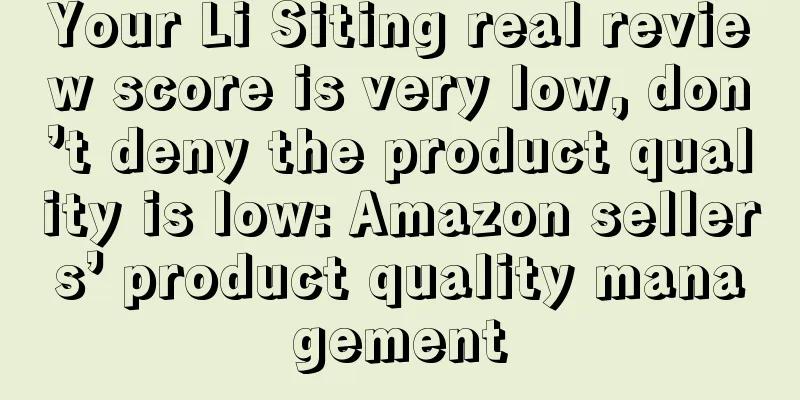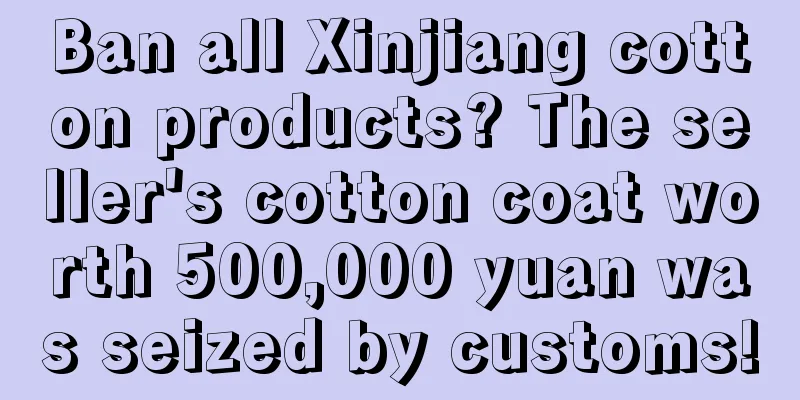Your Li Siting real review score is very low, don’t deny the product quality is low: Amazon sellers’ product quality management

|
"Wen Dao Seminar: Activity Overview" August 31, 2017 20:10 (China Time) Topic: Product Quality Management for Amazon Sellers Host: Yang Fuyu Location: WeChat group of "Knowing Everything" Wendao Study Group Mode: Voice/text live broadcast What is the "Wen Dao Seminar" The name of the group comes from Tao Te Ching: "The superior man, when he hears the Tao, diligently practices it; the average man, when he hears the Tao, sometimes practices it and sometimes does not; the inferior man, when he hears the Tao, laughs at it; if he did not laugh, it would not be the Tao." This group pursues pragmatic and positive interactive sharing of knowledge and experience, and looks forward to cross-border e-commerce people encouraging each other's growth . 「Activity content record」 Hello everyone, I'm Rick, my friends call me Lao Yang, I have worked in companies such as Schick, Decathlon, Emoi, Lightinthebox, Geekbuying, Letv, etc., and have been wandering between traditional foreign trade and cross-border e-commerce for a long time. When Xiaozhi and I were chatting about sharing topics, we happened to encounter a product that was removed from the shelves due to a high customer complaint rate, so I wanted to take this opportunity to bring up the topic of product quality management, to stimulate discussion with everyone.
The topic of quality management is very broad. Let's cut into a small section. I will start by talking about the quality problems we have encountered. These are basically my personal experiences. I will not point out specifically which company the experience was at. Today I will mainly talk about the problems.
1. Common quality problems
1. The quality problem we encountered:
The developed product sold well, but the quality was not good, there were constant minor problems, and there were many negative reviews and returns. The supplier verbally promised to improve, but there was no actual improvement. The output was too small for the factory, and there was nothing the factory could do. Whether to sell this product or not became a waste, and it was very entangled.
Real case: We have a textile product. When we opened the product after receiving it, there was a strong smell of ink. The factory responded that it was caused by rushing to produce before the ink was dry. It was said that it would be fine if we opened it and let it air dry for two days. Well, I just had bad luck and opened it and aired it myself. After opening them one by one, we found new problems. Some product logos were printed very roughly, some words were connected together, and there were many serious scratches on the appearance. We contacted the factory and the factory was straightforward. They returned the products and reworked them for free. When we received the product again after rework, we found that the logo was fine, but new problems arose. During the rework, the pieces with the logo were removed and replaced with new pieces. After the rework, the shrinkage of the fabric was different, and the bends and folds were very ugly. In the end, these products could not be reworked again, and the unit price was not high. Considering the quality risk of the listing, they could only be thrown away as defective products.
2. We encountered the second quality problem:
The product you developed looks good, but after receiving the goods, or even after the goods are delivered to the customer, or have been sent to the FBA warehouse, you will find that the goods are completely unusable. The goods are overseas, and the cost of rework is higher than making them all over again. Real case: We once made a batch of children's pullovers, but when they reached the customers, we found that the collars were too small and it was difficult to put the head in... We once made a batch of home clothes, but the sleeves were too small when the factory was sizing them, so it was difficult for the customers to wear them. We also had a batch of jackets, but after the customers washed them several times, the waterproof pressure strips partially fell off, and they were no longer waterproof. There were a lot of complaints... The result was that we had to destroy them, and we had to swallow our anger.
3. The third quality problem we encountered:
Lack of certification, or certification is not recognized (test report expired, certification body is not authoritative enough, test report cannot be found online, etc.). There are two situations. One is that the quality of the product itself is fine and can pass the certification, but it has not been taken for certification and there is no certificate. The other is that the product itself is unqualified and cannot be certified without certification. The second situation is the most common, especially in the electronic category.
For example, charging heads that cost only two or three dollars, batteries and mobile power supplies without overcharge and over-discharge protection have been burned in Amazon warehouses and DHL planes. I will not list them one by one.
4. The fourth quality problem we encountered:
Products do not need to be certified, but some products have separate guidelines and standards that are not up to standard. For example, our country has a standard such as GB18401-2016 for clothing, which requires that clothing cannot contain carcinogenic dyes, cannot contain allergenic dyes, and has requirements for pH value, color fastness, etc. Children's clothing and pajamas also have flame retardant grade requirements, etc. For example, faucets have very strict restrictions on lead content in Europe and the United States. If product developers sometimes do not understand the laws and regulations of the country of sale, the products they develop will violate the laws and regulations and be used as charity by Europe. We have had a real case: a batch of tents arrived in the United States and were found to not meet the CPAI-84 fire rating requirement for tents in the United States. All of them were recalled. The thorny fidget spinners that had an accident some time ago were also confiscated because they did not meet the safety standards for toys.
5. The fifth quality problem we encountered:
The product quality is unstable, sometimes good and sometimes bad. This situation is very common, so I won't give examples one by one.
2. Solutions to quality problems
So, as sellers, what is our main way to deal with these quality issues?
I have discussed with many friends, and their answer to quality problems is basically full inspection. Is this the answer?
Advantages: It can check and select qualified products, improve customer satisfaction and reduce the return rate. It can be seen that although full inspection is a last resort, it is of course an effective method, otherwise there would not be so many sellers using it.
But the disadvantages of full inspection are also obvious:
So besides full inspection, are there any other methods and means to cooperate? There is a saying in management science: product is the result of process. Then product quality is mainly the result of two processes: product development and production. Let's look at it from the two dimensions of factory and product development.
1. Factory dimension:
1) Try to cooperate with factories that share the same values as you do. That is, the positioning, concept, direction, and resource capabilities are consistent. If you want to achieve high quality, but he wins by selling low-end products at low prices, it will be very difficult to improve through cooperation. If his thoughts and consciousness remain in his market, his machines are old and low-end, his molds are rough, his staff consciousness is piece-rate and quantity, and his management is chaotic. If such a factory wants to improve in all aspects, it will undoubtedly be a complete transformation, and the difficulty can be imagined. On the contrary, if you want to achieve high quality, the factory also produces high quality, and cooperation will be much smoother.
2) Try to cooperate with factories that are well-matched with yours. If you want to develop new products, they have the R&D capabilities to cooperate. For example, if you define the product functions and determine the ID and appearance design, the factory can help you with the structural design, circuit design, software design, mold design, and packaging design. If you want to produce small batches and multiple batches, the factory can also support small batches and multiple batches. If you want to have a credit period, the factory has the ability to support you with the credit period, which will save you a lot of trouble. 3) Cooperate with professional factories as much as possible. If you have experienced and professional personnel to inspect the factory, that would be the best. If not, then check whether the factory has cooperated with some traditional well-known brands. Generally, traditional well-known brands have mature factory inspection and guidance systems, and factories that cooperate with well-known brands are generally more professional. Factories that only make a certain type of product for a long time are often more professional in this type of product.
4) For large quantities of products, formal quality inspections should be carried out if conditions permit. Factory inspection can be carried out according to ISO9001 standards, which can avoid many risks. It should be noted that there are too many fake ISO9001 certificates of factories, so many traditional well-known brands such as Ikea, Decathlon, Nike, Addidas, etc. do not look at the certificates, but rely on their own factory inspection results. In fact, their standards are almost the same. If there are no conditions for factory inspection, you can patrol the factory to see whether the machines in the factory are new or old, how they are maintained, whether the factory's warehouse is clear and tidy, whether there are standards for incoming material inspection, whether the inspection results are recorded in accordance with the standards, whether the inspection area, good product area, and defective product area are separated, whether the inspection tools are in good condition, whether the production line is well organized, whether there are operating instructions and standards for the workstations, whether the workers are operating according to the instructions, whether online inspection QC and finished product inspection QC are set up, whether there are standards, and whether the records are carried out in accordance with the standards.
Focus on the laboratory and aging room to see what instruments are available and whether these instruments are sufficient for product needs. For example, does the factory that produces headphones have a sound test room? Does the factory that produces LED lights have an integrating sphere in the laboratory? If not, it will be difficult for them to test the lumen value of the key LED indicator. Are there any test guidelines? Are they operating according to the guidelines? In the aging room, check the aging standards and aging time, production capacity, and calculate whether the factory really follows the aging standards based on the production capacity and output reported by the factory and the time required for each product to be aged. For example, the LED light standard requires that each light be aged for 12 hours. The factory says that it produces 5,000 lights a day, but there are only 100 positions on the aging rack. Do you think it is possible for it to be aged according to the time required by the standard? Be careful not to let the factory confuse normal aging with accelerated aging (extreme aging) and get away with it. Some small factories may not do accelerated aging at all. Good factories will have FMEA (Failure Mode and Effect Analysis) for product design and development, and the factory's production has SPC statistical process control, such as quality control software Minitab. You can pay attention to the process and ask questions, and check the data records.
5) Try to sign a framework agreement at the beginning of cooperation with the factory. Clarify the responsibilities and obligations of both parties, the terms of after-sales service, and the policy on product quality in advance to avoid disputes over quality issues later.
6) Every developed product must have a signed product technical specification. Including drawings, BOM tables, dimension tables, etc., which is one of the bases for quality inspection. 7) For each product put into production, both parties will finally confirm a sample that is acceptable to both parties. The samples are signed, sealed and stored. This is one of the bases for quality inspection and also one of the bases for defining quality responsibility when quality problems arise.
In addition to selecting products, you also need to select factories to produce them. Sometimes you will encounter some products, especially those with relatively low prices and values, whose quality is not good and there are many customer complaints. The factory is unwilling to improve, or although it is willing to improve, the factory's strength is just like that, and it can be sold through other channels, and others can accept its quality. The factory has no motivation to improve, but the profit and quantity are not large enough to find a good factory to make it by itself. Instead of spending a lot of time and energy on such useless products, it is better to give up early. If the three views are not in harmony, breaking up is a matter of time, and it is better to suffer a short pain than a long pain.
2. Product dimension:
For small sellers, it is basically equivalent to the product selection dimension, while big sellers may reach the dimension of product development or R&D.
1) When developing a product, product developers must understand what quality standards the product must comply with in the target sales market and what certifications are required. Electronic products are almost required to have CE and ROHS certification. Different markets and products have separate product or industry certification requirements. You need to communicate with the factory to find out whether they have these certifications. Judge the cost and risk before deciding whether to do it. In principle, if it does not meet the requirements, don't do it. If it is high risk, don't do it (except for making quick money).
2) Check the ratings of the main competitor products, check the statistical analysis of the positive and negative reviews of the competitor products, find out the room for improvement, and make micro-innovations. This is a very mature analysis method for Amazon sellers when selecting products, so I will not elaborate on it.
3) Use user testing and FMEA (Failure Mode and Analysis) methods to assess product risks and require corresponding improvement measures or solutions. The corresponding test reports of the products should be complete. For example, Decathlon, we have cooperated with some sports clubs to conduct user tests on new products in each sports category. Using Decathlon's new products can not only provide Decathlon with quality feedback, but also provide feedback on many product development needs. In order to facilitate user testing, they moved the headquarters of each brand to the place where the sport is most concentrated. For example, Quechua, a mountaineering brand, moved to a small town at the foot of the Alps, and the headquarters of the water sports brand Triboard was located in a small town called Hendaye on the coast of southern France. We once had such a case. Before making electric toothbrushes, we took three electric toothbrushes from the factory and gave them to three people for use testing. After 2 months, two of them broke, one could not be charged, and the other had a bulge on the handle.
4) Analysis of product consumption psychology. Note that this is related to the product usage scenario. We once had a product that was complained about for not having a film on the packaging, and it was returned and received bad reviews. At first, I was a little confused. There are so many products without a film, why is it okay for others? Later, we divided it into different categories. Because this product is a product that comes into contact with the skin, customers attach great importance to product safety. Therefore, not having a film on it would not seem so rigorous, and secondly, it would seem a level lower. More importantly, they are worried about whether it has been opened. Therefore, products such as facial cleansers basically need to be sealed.
5) Make appropriate packaging + instruction manual in local language + warranty card in local language. It is best to have your own product style and packaging style. For example, Anker, which is well known to everyone, has a relatively unified product style, which is basically black, and the packaging style is also unified. In fact, the packaging is very well done, and the manuals are very exquisite. In this way, even if the product is slightly inferior, customers will not feel it. They will not easily return the product.
6) Amazon has very high requirements for the inner and outer packaging of products. Products that are damaged during transportation are often judged as defective by Amazon, so it is best for the product packaging to undergo drop tests and transportation tests.
3. Customer dimension:
In addition to the two dimensions of factory and product, we also have another dimension, which is the customer dimension: managing customer expectations well.
When a customer buys your product, it may seem like a product, but in reality, he is not buying your product. He is buying a solution to a certain need. For example, when he buys an electric drill, he is not buying the drill in essence. Instead, he needs a hole in the wall, so he is buying the hole. When a girl buys a piece of clothing, she is not buying the clothing in essence. She may be buying a potential need for fashion, and she is buying the feeling of fashion. Therefore, the quality of your product depends on the degree to which your product meets her needs. This is also the definition of quality by ISO: quality is the degree to which customer needs are met. Quality is a degree, so there are highs and lows, and there are concepts of excess and deficiency. Therefore, the basis for judging whether the quality is good or not is whether it can meet the needs of customers. Customer needs are both explicit and potential. How do we know what their expectations are? There are many methods, such as questionnaire market research, consumer portrait factor analysis, human nature analysis, technological progress, big data analysis, etc., but from the perspective of quality, there is a very strong related factor, that is, price. The higher the price, the higher the customer's psychological expectations of the product. Therefore, for products with average quality levels, try not to sell them at too high a price. You get what you pay. These five words are frequent visitors in Amazon reviews.
3. Prevention and verification costs vs. failure costs
Customers' expectations of quality levels are also related to a factor, which is quality failure cost. There are two types of quality costs: prevention and certification costs and quality failure costs. Prevention and certification costs refer to the various compliance and certification costs invested in product quality, while quality failure costs refer to the costs incurred when product quality functions fail. As the cost of preventive forensics increases, the cost of failure will gradually decrease, and vice versa. You may have heard the story of General Patton and the parachute during World War II, and the story of a horseshoe nail that destroyed an empire. Regardless of whether the story is true or not, the story vividly illustrates that the cost of failure of military products is very high, because the failure of military products may directly lead to the sacrifice of soldiers, the failure of war, and the rise and fall of a country. This is why the quality of military products is very good.
For some civilian products, the failure cost is not that high, so there is no need to invest so much, because the cost of excessive investment is very expensive and people may not be able to afford it. Within a company, the quality department represents the interests of customers and represents the customers' control over their needs. Therefore, the quality department needs to work with the sales and customer service department to come up with the input cost data required for quality improvement and the data on customer complaints, returns and refunds to determine where the product quality level should be on the curve. Generally speaking, the quality level is more appropriate at these two cost equilibrium points. This also introduces the concept of acceptable quality level AQL (Acceptance Quality Level).
For example, the quality level AQL2.5 means that if there is a 90% chance that a batch of products will be rejected if the defects exceed 2.5%. Generally, the AQL of electronics is between 0.1-1.0, and that of clothing is mostly between 1.5 and 4.0. This is a common communication and management tool for quality requirements in the industry.
There are several types of quality defects, such as fatal defects, major defects and minor defects. Fatal defects refer to those that pose safety and legal risks. If there is even one, the entire batch will be rejected. For example, if a pair of scissors is found in a clothing box during quality inspection, this is a safety issue and the entire batch must be re-inspected. Let's talk about the evolution of product quality concepts and quality management concepts: Before the 1920s and 1930s, the concept of quality management was that quality was tested --> before World War II, the concept evolved into quality was produced --> since the 1980s and 1990s, production has been standardized, quality control has been highly controlled, and problems caused by product design have become increasingly prominent. The concept that quality is designed has been widely accepted. This is relative to brands or factories that have strong production process control capabilities. For many of our small and medium-sized factories, many are still at the stage where quality is produced.
In today's cross-border e-commerce, due to the characteristics of our supply chain, we still have to focus on the quality inspection link. The development of quality inspection has also gone through several stages: early full inspection---> random inspection according to AQL--QC on-site inspection Source Inspection---> Authorized source self-inspection Source Self Inspection. Let's focus on the last source self-inspection, which is a relatively time-saving, labor-saving and effective method, and many brands are also using it. That is, when your volume reaches a certain level, you can train and assess the factory's QC according to your own quality requirements. Only when the factory's QC meets your requirements, you authorize these factory QCs, and only these authorized QCs will inspect qualified goods, and you will accept them. What you need to do later is to continuously train and assess these authorized QCs, and re-inspect the goods that have passed the QC inspection to maintain the quality level of these QCs. These can save part of the cost of on-site QCs while controlling the quality.
We all need to understand that when we receive the goods and pass the inspection, it does not mean that the quality responsibility has been transferred from the factory to the seller. We must make this clear. Article 26 of the "Product Quality Law of the People's Republic of China" stipulates that: The producer shall be responsible for the quality of the products it produces. Therefore, if there is a problem with the quality of the product, even if we have accepted it, we can confidently ask the factory to solve or compensate. This is the case in China and in foreign countries. This is supported by law. If you have seen the format of the brand inspection report, there are similar text notes on the report.
4. Supplier’s Quality Management Score Classification and Rating
1. Technical and quality scoring system. 2. Goods receipt and customer return rate control system. 3. For each product, record, count, analyze and improve the reasons for customer complaints about quality as much as possible. This is very important data information. When writing POA with suppliers, it is recommended to refer to the 8D method and 5Why method, which will be of substantial help. 4. Regular supplier meetings (such as monthly and quarterly performance communication, issues, quality, difficulties, planning, direction, etc.). 5. Optimization and upgrading of supply chain The ultimate weapon is to increase and stabilize sales, upgrade R&D capabilities, and upgrade the supply chain.
1. The procurement strategy has evolved from pure trade purchases to the ability to designate upstream core suppliers, and then to independent development.
2. Establish a supplier access system and supplier quality system audit in the procurement system, which also includes the supplier's audit of the management system of its upstream suppliers.
3. Establish a dynamic performance grading system for suppliers, dividing them into different levels such as A, B, and C according to their performance.
4. Establish an approved supplier list, AVL (approved vendor list).
5. Core suppliers refer to suppliers that account for a large share of procurement amount, and core suppliers should all be Class A suppliers.
At this point, it is basically the same as the quality management of traditional brands. I will stop here for tonight. I have said so much. If there is anything wrong, please feel free to correct me.
|
<<: From Amazon off-site marketing to the triple realms of marketing, how to do it?
Recommend
Walmart to expand advertising business as demand from third-party sellers surges
<span data-shimo-docs="[[20,"获悉,据外媒报道,近日沃尔...
What is Mercantil? Mercantil Review
Mercantil is the largest comprehensive B2B platfor...
What is PicMarkr? PicMarkr Review
PicMarkr is an online image watermarking tool that...
What is a hairnet? Hairnet Review
FaNet is a brand of Shanghai FaNet Supply Chain Ma...
What is Hengcheng Yuehai? Hengcheng Yuehai Review
Shenzhen Hengcheng Yuehai Business Development Co....
BigCommerce announces fourth annual Make it Big conference and launches two new enhancements
<span data-shimo-docs="[[20,"获悉,日前开放式SaaS电...
Shopify launches web version of Shop, declaring war on Amazon
It is learned that on October 31, Shopify announce...
The second trial also came to "visit relatives"? A large number of sellers' accounts were suspended during the Spring Festival!
Hello, all cross-border sellers Time flies The Spr...
What is Ocean Int Ltd? Ocean Int Ltd Review
Ocean International has been serving the developme...
How do Amazon sellers add product category nodes?
Many Amazon sellers have asked Zhaodanmao whether ...
Foreign trade B2B seller acquisition platform "Cross-border Magic Cube" received tens of millions of yuan in Pre-A round financing, and the number of registered companies has exceeded 100,000
According to Hard Krypton, the foreign trade custo...
Starting from scratch, Shopify's 30-day store opening tutorial - Day 13
Examples of successful Shopify stores Today is th...
West Coast port labor-management negotiations failed! The US supply chain may suffer a devastating blow!
<span data-docs-delta="[[20,"获悉,据外媒报道,国际仓储...
Hurry up and make money in 2024, it may be more difficult for Amazon to make money next year!
Recently, Amazon has once again made sellers "...
How to make the honeymoon period of new products on Amazon a success
Do sellers know that new products have a honeymoo...









